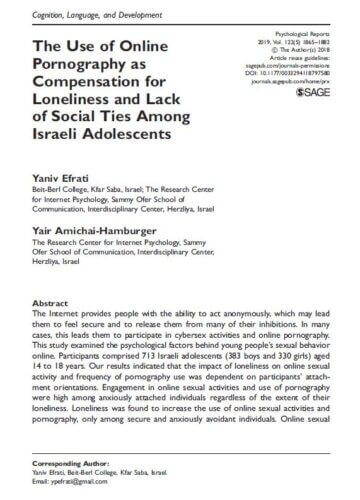Mental Health
The Use of Online Pornography as Compensation for Loneliness and Lack of Social Ties Among Israeli Adolescents
Open Access: No.
Abstract
The Internet provides people with the ability to act anonymously, which may lead them to feel secure and to release them from many of their inhibitions. In many cases, this leads them to participate in cybersex activities and online pornography. This study examined the psychological factors behind young people’s sexual behavior online. Participants comprised 713 Israeli adolescents (383 boys and 330 girls) aged 14 to 18 years. Our results indicated that the impact of loneliness on online sexual activity and frequency of pornography use was dependent on participants’ attachment orientations. Engagement in online sexual activities and use of pornography were high among anxiously attached individuals regardless of the extent of their loneliness. Loneliness was found to increase the use of online sexual activities and pornography, only among secure and anxiously avoidant individuals. Online sexual activity and pornography were also found to be related to offline sexual activity. The results are described and discussed.
Relevance
Pornography use was high for adolescents with attachment anxiety regardless of whether they are lonely or not. (“Anxiously attached people energetically attempt to achieve closeness, support, affection, and love, but they also lack the confidence that these resources will be provided and are afraid of being rejected by others. Thus, online sexual activity and online pornography may serve as a compensation for anxious adolescents.”)
Pornography use was also high for adolescents who are low on attachment anxiety (or secure) but were nonetheless lonely.
Adolescents who are secure in their relationships and in their attachments had low use of pornography.
Citation
Efrati, Y., & Amichai-Hamburger, Y. (2019). The Use of Online Pornography as Compensation for Loneliness and Lack of Social Ties Among Israeli Adolescents. Psychological reports, 122(5), 1865–1882. https://doi.org/10.1177/0033294118797580

